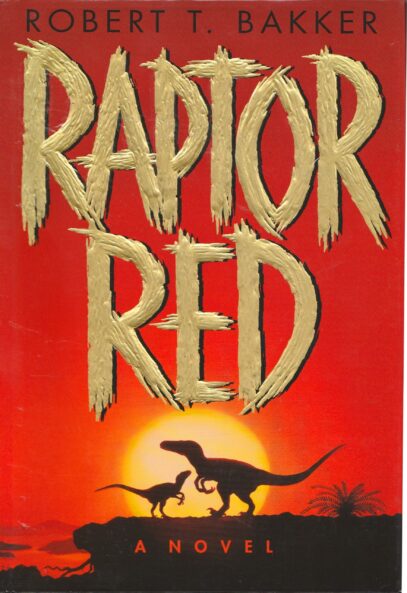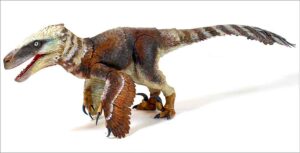By ROBERT T. BAKKER (Bantam; 1995)
The 1990s dinosaur craze found a most unexpected apotheosis in RAPTOR RED, a Cretaceous Period set novel told from the point of view of a raptor—or rather Utahraptor, which refers to a species of dinosaur that was apparently the “biggest and strongest in North America.”
Author Robert Bakker is a paleontologist famous for revolutionizing dinosaur studies (by theorizing that dinos were warm rather than cold-blooded) and for being a technical advisor on JURASSIC PARK. It should come as no surprise that RAPTOR RED often reads more like a scientific treatise, complete with opening and closing chapters that detail the novel’s historical background (including details of Bakker’s contributions to JURASSIC PARK), than the Spielbergian romp it was marketed as. Still, Bakker is to be commended for keeping the proceedings lively, with a creditable saurian protagonist and a present tense narrative “pieced together from the fossil remains of Utahraptor and from clues about her world locked up in Early Cretaceous sediments” that incorporates danger, intrigue and romance.
Said protagonist is a female Utahraptor who lives to hunt and kill, but is extremely intelligent and capable of great sentiment. She’s known as Raptor Red because “that’s how she identifies herself in her own mental imagery.” Her toughness is borne out by the fact that she’s managed to live past one year, a milestone most raptors apparently don’t reach. This, however, doesn’t stop her male mate being killed early on in the book, leaving Raptor Red to face the harshness of the prehistoric world alone.
Luckily, she runs into her sister and the latter’s three offspring. Raptor Red forms a close bond with her sibling, becomes a surrogate mother to the three “chicks” and even finds a new mate, but she still has to contend with a thousand year flood, a drought, a snowstorm and the ever-present specter of death, which strikes down more than one of her loved ones.
In keeping with his protagonist’s violent nature, Bakker includes much graphically detailed flesh ripping and blood-letting (“The sharp-edged hindclaws slice deeply through the body wall of the bull…Gaping wounds five feet long expose his vital organs to the outside. The raptors strike again and again, carving up the still-living mass”). Textual sound effects (“SsssssSSSSSSSS,” “Whummp!,” “BlaacccCCh!,” etc.) enhance the visceral feel.
Other interesting details related by Bakker include the raptors’ method for dealing with ticks—by allowing birds to alight on their backs and dig the insects out with their beaks—and their practice of making high marks in tree trunks to show fellow predators how tall they are. We also get copious info on miscellaneous Cretaceous wildlife, which includes pterodactyls, turtles (who lead lives of “comfortable monotony that would bore Raptor Red to death”) and the long-extinct Aegialodon, an enthusiastic bug-chomper who’s instrumental in keeping potentially deadly insects from felling Raptor Red and her family.
Most notable is the language Bakker uses, which goes out of its way to render its descriptions accessible to the layman. The line “Raptor Red yells in exasperation,” for instance, is explained thusly: “The hoarse scream means You IDIOT!” Similarly, a mate-less bull is dubbed an “elderly loser,” a pterodactyl’s morning stretches a “preflight warmup” and the site of a dino mating ritual a “dance floor.” The wisdom of this practice is certainly debatable, with “accessible” being dangerously close in literary terms to “dumbed down,” but ultimately RAPTOR RED works, pure and simple.


